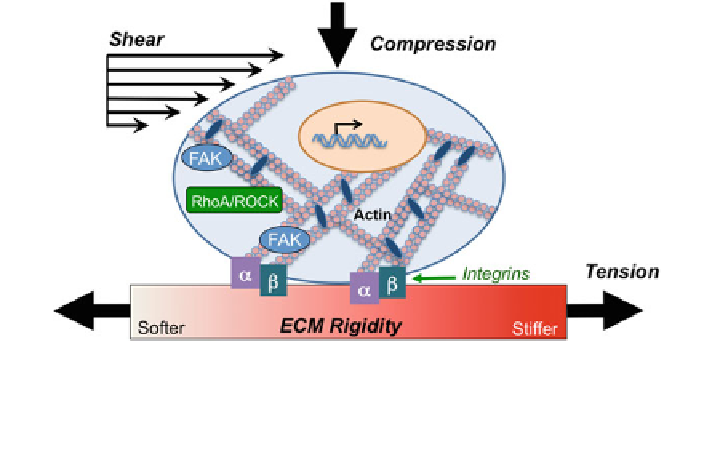Biomedical Engineering Reference
In-Depth Information
Fig. 2 Pre-adipocytes and adipocytes may experience a variety of mechanical forces in vivo
including shear, compressive and tensile stresses, as well as ECM rigidity. These forces may be
transmitted as signals intracellularly via transmembrane proteins (e.g., integrins) and cytoskeletal
components (e.g., actin filaments) and activate various signaling pathways. This figure was
modified from Schiele et al. [
62
]
tensile strain, and suggested that the cellular responses are elicited only after a
tensile strain threshold has been crossed [
58
]. The mechanism of enhancing lipid
droplet formation by sustained static stretch appears to be independent of PPARc
activation. Instead, the aforementioned study by Shoham et al. implicated the
MEK/MAPK pathway based on the observation that inhibiting this signaling
pathway attenuated the effects of the tensile strain.
In addition to magnitude, the effects of tensile strain also depend on the
developmental stage of the cell. Hara et al. found that constant uniaxial static
stretching of differentiated 3T3-L1 hypertrophic adipocytes to 120 % of their
initial length resulted in increased stress fiber formation and activated the Rho-
Rho-kinase pathway, which is implicated in the initiation and development of
obesity [
38
]. They also found this pathway to be activated in adipocytes after size
increase during normal cell growth.
In contrast, static compression of Simpson-Golabi-Behmel syndrome cells, a
preadipocyte cell line, at 226 Pa for 12 h prior to treatment with adipogenic
medium resulted in inhibited adipogenesis [
59
]. Interestingly, application of
compressive force after induction of adipogenesis had no effect. Moreover, the
inhibitory effects seemed to be modulated via suppression of PPARc as a function
of COX-2. It is challenging to draw definitive conclusions about the use of static
loading to activate or enhance adipogenesis from a limited number of studies, but
it is intriguing to consider that static loads are able to affect stress fiber organi-
zation, which has also been reported in studies investigating the effects of substrate
stiffness on cell behavior.

Search WWH ::

Custom Search